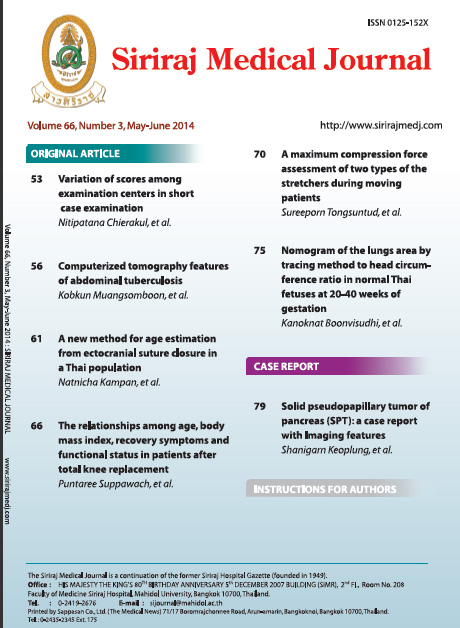A Maximum Compression Force Assessment of Two Types of the Stretchers During Moving Patients
Abstract
Objective: To assess the maximum compression forces of the back while laterally transferring patients from beds to stretchers with different heights of personnel and different types of stretcher.
Methods: The maximum compression forces of the back when moving patients were used to record the movement of sub- jects by CCTV. SUTStructore Program was used to compute the maximum compression forces of the back. The independent variables, postures, heights of the subject, and type of stretchers were analyzed by SPSS version 13.0.
Results: The maximum compression forces on the back with postural variables were the highest during the curve posture. The height variable revealed that the least maximum forces occurred to the subject with 160-165 centimeters height. Considering the maximum forces occurred at the back, the result showed that the maximum compression forces to move patients with adjustable stretchers could relieve force more than those which occurred with non-adjustable stretchers.
Conclusion: The maximum compression forces of the back while transferring patients with adjustable stretchers was lower than the maximum compression forces with non-adjustable stretchers. Additionally, the height of subjects when transferring patients from beds with 70 centimeters to 70 centimeters and 84 centimeters height of stretchers reveals that patients with 160-165 centimeters height were suitable to transfer from beds to this height of stretchers.
Keywords: Moving patients, lateral transfer, SUTStructore, maximum compression forces.
Siriraj Med J 2014;66:70-74
Downloads
Published
How to Cite
Issue
Section
License
Authors who publish with this journal agree to the following conditions:
Copyright Transfer
In submitting a manuscript, the authors acknowledge that the work will become the copyrighted property of Siriraj Medical Journal upon publication.
License
Articles are licensed under a Creative Commons Attribution-NonCommercial-NoDerivatives 4.0 International License (CC BY-NC-ND 4.0). This license allows for the sharing of the work for non-commercial purposes with proper attribution to the authors and the journal. However, it does not permit modifications or the creation of derivative works.
Sharing and Access
Authors are encouraged to share their article on their personal or institutional websites and through other non-commercial platforms. Doing so can increase readership and citations.










